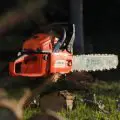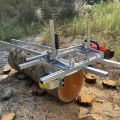Chainsaw kickback is a common phrase that is thrown around when discussing the operation of chainsaws. To be able to ensure absolute safety, it is very important that you’re well-versed in what it is, what causes it, and how to handle/avoid it. Understanding these points can really be the difference between successfully operating your chainsaw and serious injury.
This article will provide you with all the relevant information on chainsaw kickback so that you know how safely use your chainsaw with little to no worries.
Table of Contents
- What Is Chainsaw Kickback?
- How to Prepare Yourself for Kickback
- How to Avoid Chainsaw Kickback
- FAQs (Frequently Asked Questions)
What Is Chainsaw Kickback?
Chainsaw kickback is the term that is used to describe the sudden jolt by the chainsaw in an upward direction during operation. It can be very hazardous and is typically one of the most common causes of accidents involving chainsaws. When the chainsaw decides to bite back there is basically nothing you can do so it is always important to be aware of how it can occur and how to prepare against it.
Kickback is caused when the chain gets snagged trying to cut through a tree. The engine power is still providing energy and this energy has to go somewhere. And as a result of Newtonian physics, where the reaction is equal and opposite, this will cause the chainsaw to kick back.
What’s worrying is that this basically means that the more the chainsaw gets stuck, the more violent the kickback will be and the more potential harm you’re putting yourself in.
The most common place this will happen is on the chainsaw blade’s kickback zone, which is the 90° angle at the top of the chainsaw. If you ever use this point of the chainsaw to make a cut, it’s very easy for the blade to momentarily get pinched on the wood and result in a kickback.
There are a number of other factors, mostly based on the setup and maintenance of the chainsaw, that can increase the chances of experiencing kickback too.
If the chainsaw blade becomes dull due to a long life this will increase the likelihood of a kickback occurring, as it will no longer be so capable of cutting through the wood. On top of this, if the chainsaw chain is loose and not tight enough then the efficiency of the chainsaw will be affected and the risk of kickback increases.
How to Prepare Yourself for Kickback
If and when, the chainsaw decides to bite back there will be almost nothing you will be able to do to stop it. You must always be prepared for this happening, first by wearing the right personal protective equipment (PPE).
It is imperative that you are wearing the correct PPE gear before starting any chainsaw operation. The chainsaw is most likely to kickback upwards so you will need to make sure you have a helmet on, preferably with a visor to protect your eyes.
It’s also strongly recommended that you purchase the correct type of jacket, trousers, gloves, and boots before you start work as they could possibly be the key difference between life and death if the chainsaw does decide to kick back.
How to Avoid Chainsaw Kickback
To be able to reduce the risk of chainsaw kickback and the associated chainsaw kickback injuries, there are a number of different things you can do to minimize the frequency. Here are some tips on how to prevent chainsaw kickback:
- Read the manual
- Make sure the chain brake works
- Use a low-kickback chain
- Ensure the chain is sharp
- Pay attention to the nose of the chainsaw
- Be cautious when felling tree trunks
Read the Manual
Reading the manual for specific instructions for your chainsaw should be your first port of call, especially if you lack much if any experience with chainsaws. The user manual will provide you with all the crucial information on how to use your chainsaw safely and avoid injuries.
Make Sure the Chain Brake Works
The chainsaw brake is a very important component of a chainsaw, arguably one of if not the most. The chain brake can be used when you’re changing position without turning off the whole chainsaw, but it is also very valuable in helping reduce kickback.
The chain brake can be activated during kickback conditions, stopping the chain and aiding to prevent serious injuries.
Use Low-Kickback Chains
There are chains available that are designed better than others to reduce kickback. Low-profile or semi-chisel chains are ideal for beginner chainsaw users, as they are generally designed to endure less kickback.
A full chisel chain has square-cornered cutting teeth, which are able to cut through wood quicker but also have a higher risk of kickback.
Use a Sharp Chain
A dull chain can cause kickback, as the teeth will not be able to cut through the wood, which will cause the chain to get stuck and cause kickback.
Pay Attention to the Nose of Your Chainsaw Bar
It’s important to avoid the kickback zone when you’re cutting, making sure you use the correct part of the blade and never the tip/nose. Your user manual will have more information on this for your specific chainsaw.
Be Cautious When Felling Tree Trunks
If the chainsaw nose strikes a log or hidden branch you will be at risk of kickback. It’s imperative that you’re careful when climbing any trees as the risk is generally higher.
Along with this, ensure you have balance if you’re on a ladder as a violent kickback may throw you off.
More chainsaw troubleshooting:
- How to Port a Chainsaw
- Are Chainsaw Bars Interchangeable
- How to Unflood a Chainsaw and Start It Once Flooded
FAQs (Frequently Asked Questions)
What is the most common chainsaw injury?
Chainsaw kickback is the most common injury associated with chainsaws, and it poses the greatest hazard. Kickback occurs when the rotating chain has stopped suddenly by contact with a more solid area throwing the saw rapidly back in the direction of the operator.
What is chainsaw pushback?
Pushback, more commonly known as a kickback, is when the chainsaw chain on the top of the bar is suddenly stopped. The sudden stop of the bar rapidly drives the saw back toward the operator. Pull-in occurs when the chain on the bottom of the bar is suddenly stopped when it is pinched, catches on the wood, or encounters a foreign object.
What is a kickback brake on a chainsaw?
In the event of a chainsaw kickback, the brake is designed to engage automatically through the force of inertia. Since kickback occurs suddenly and with great force most people cannot react fast enough to activate the chain brake manually. So, the brake is engaged through the kickback force and brings the chainsaw to a halt to reduce the likelihood of injury.
What causes a kickback?
Kickback generally is caused when the chain on the bottom of the bar is forced to come to a sudden stop when it is pinched, catches on the wood, or encounters a foreign object in the tree. The chainsaw will pinch if you’re using the tip of the chainsaw blade, hence why it is recommended to not use this zone of the chainsaw to make a cut.






